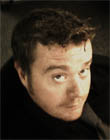|
|
This topic comprises 2 pages: 1 2
|
|
Author
|
Topic: Open Captioned Prints
|
|
|
|
|
|
|
John Pytlak
Film God

Posts: 9987
From: Rochester, NY 14650-1922
Registered: Jan 2000
|
 posted 06-13-2000 08:57 AM
posted 06-13-2000 08:57 AM





Open Captions and Subtitles can be printed in several ways.When many captioned prints are needed, a B&W negative with the captions (black letters against a clear background) is printed "bi-pack" with the picture negative and print stock on a special contact printer. The black letters hold back the exposure, leaving white letters on the final print. The extra layer of film during printing does lose some sharpness. Chemical etch subtitles are produced by coating the emulsion of the processed print with wax. Metal type is used to emboss the wax in the areas of the letters, similar to the way mimeograph masters used to be made. The film then goes into a bleaching solution, which removes the emulsion in the areas unprotected by the wax, producing clear letters. The wax is then removed from the film. Laser subtitles are produced by scanning a high-powered argon laser beam on the film, ablating (burning) the emulsion off with the high energy laser beam. Chemical etch and laser subtitles can be put on used prints, such as "rejuvenated" US prints that find their way overseas. They are more cost-effective than "bi-pack" subtitles when only a few prints are needed, but for large orders, the subtitles are usually printed in. One company that specializes in subtitling is Titra: http://www.titra.com I believe they did the work on "Erin Brockovich". ------------------
John P. Pytlak, Senior Technical Specialist
Worldwide Technical Services, Entertainment Imaging
Eastman Kodak Company
Research Labs, Building 69, Room 7419
Rochester, New York, 14650-1922 USA
Tel: 716-477-5325 Fax: 716-722-7243
E-Mail: john.pytlak@kodak.com
| IP: Logged
|
|
|
|
|
|
|
|
|
|
|
|
|
|
|
|
|
|
|
|
|
|
|
|
|
|
All times are Central (GMT -6:00)
|
This topic comprises 2 pages: 1 2
|
Powered by Infopop Corporation
UBB.classicTM
6.3.1.2
The Film-Tech Forums are designed for various members related to the cinema industry to express their opinions, viewpoints and testimonials on various products, services and events based upon speculation, personal knowledge and factual information through use, therefore all views represented here allow no liability upon the publishers of this web site and the owners of said views assume no liability for any ill will resulting from these postings. The posts made here are for educational as well as entertainment purposes and as such anyone viewing this portion of the website must accept these views as statements of the author of that opinion
and agrees to release the authors from any and all liability.
|

 Home
Home
 Products
Products
 Store
Store
 Forum
Forum
 Warehouse
Warehouse
 Contact Us
Contact Us




 Printer-friendly view of this topic
Printer-friendly view of this topic




















